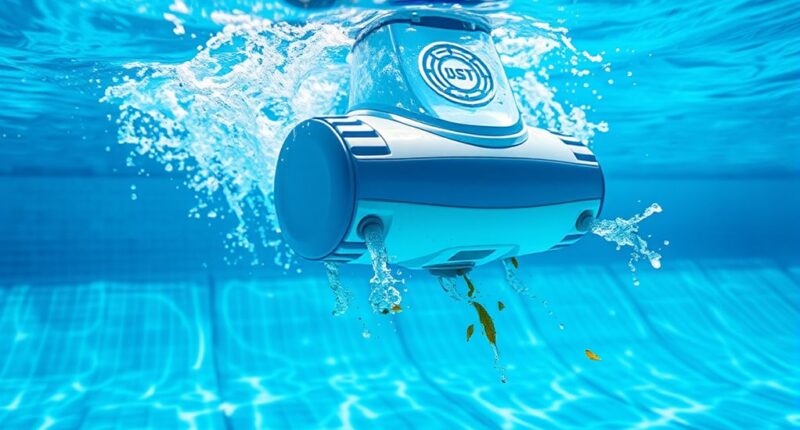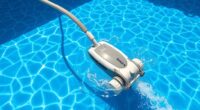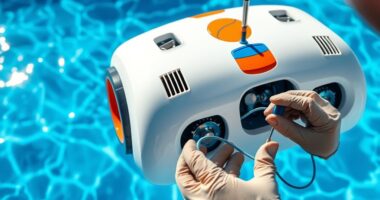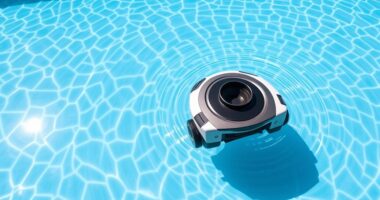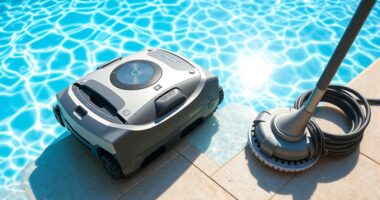Pressure pool cleaners attach directly to your pool’s return jet, using high-pressure water to move and scrub surfaces. They harness the water flow to propel themselves along the pool floor and walls, automatically steering to cover large areas. Inside, a debris chamber collects dirt, leaves, and other debris as it’s vacuumed away. This efficient system keeps your pool clean with minimal effort, and if you keep exploring, you’ll discover more about how these clever devices work.
Key Takeaways
- Attach to the pool’s return jet to utilize existing water pressure for movement and cleaning.
- Use high-pressure water flow to propel the cleaner along pool surfaces and walls automatically.
- Contain a debris chamber or filtration bag to collect dirt, leaves, and other debris during operation.
- Incorporate navigation mechanisms like fins or guide vanes to ensure thorough and systematic cleaning coverage.
- Operate independently, requiring minimal manual effort, while efficiently cleaning large areas and handling various debris types.
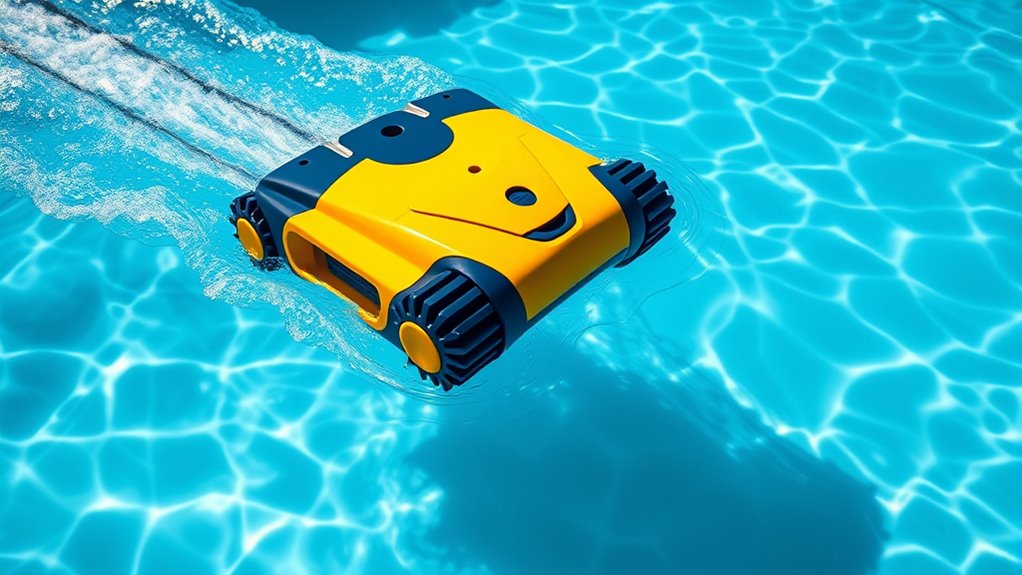
Pressure pool cleaners are a popular choice for keeping your pool spotless because they use the force of water pressure to efficiently remove dirt and debris. These cleaners operate by attaching to your pool’s existing return jet and utilizing high-pressure water to power their movement and cleaning functions. As water is forced through the cleaner, it propels the device along the pool’s surface and walls, allowing it to cover large areas without much effort from you. This method makes them a reliable and straightforward option for regular maintenance.
One of the key features that set pressure pool cleaners apart is their automated navigation system. Unlike manual vacuums, pressure cleaners often incorporate simple mechanical or automatic navigation mechanisms that help them move systematically around the pool. Some models rely on weighted bodies, fins, or guide vanes to steer and change direction when they encounter obstacles or pool edges. Others may use more advanced automatic navigation systems that map out the pool’s shape and plan an efficient cleaning route. This automatic navigation ensures thorough coverage, reducing the chances of missed spots and saving you time. You don’t have to constantly adjust or reposition the cleaner; it works independently, making your pool cleaning routine much easier. Additionally, advanced navigation systems can optimize cleaning paths for faster and more thorough coverage.
Debris removal is another critical aspect of how pressure pool cleaners operate. As the cleaner moves around, it picks up dirt, leaves, twigs, and other debris from the pool floor and walls. Inside the device, a filtration bag or debris chamber collects all the mess, preventing it from recirculating into the water. Because pressure cleaners use a continuous water flow, debris is effectively dislodged from surfaces and carried into the collection chamber. This process keeps your pool water clear and reduces the need for manual scooping or additional cleaning tools. Furthermore, many pressure cleaners are designed to handle various debris types, from fine particles to larger leaves, making them versatile for different pool environments. Additionally, vacuum technology enhances their debris removal efficiency, ensuring your pool stays cleaner for longer.
Frequently Asked Questions
Can Pressure Pool Cleaners Remove Algae From the Pool?
Yes, pressure pool cleaners can help with algae removal, but they work best when combined with proper chemical balancing. As you use the cleaner, it stirs up algae and debris, making it easier to vacuum or filter out. However, for thorough algae removal, you should also adjust your pool’s chemicals, like chlorinating and balancing pH levels, to prevent algae from returning and keep your pool crystal clear.
Do Pressure Pool Cleaners Work in All Pool Types?
Most pressure pool cleaners perform perfectly on various pool surfaces, from concrete to vinyl, providing powerful debris removal. You’ll find they work well in different pool types, but some may struggle with delicate surfaces or intricate corners. You’ll want to verify compatibility before use. Pressure cleaners efficiently clear debris, ensuring your pool stays pristine and inviting, making maintenance manageable and more enjoyable.
How Often Should I Service My Pressure Pool Cleaner?
You should service your pressure pool cleaner at least once a season, or more often if you notice it’s not cleaning effectively. Following a maintenance schedule helps prevent issues and extends its lifespan. Use troubleshooting tips like checking hoses for leaks or clogs, inspecting the filter, and ensuring proper water pressure. Regular maintenance keeps your cleaner running smoothly, saving you time and ensuring a clean, inviting pool all season long.
Are Pressure Pool Cleaners Eco-Friendly and Energy-Efficient?
Think of your pressure pool cleaner as a green warrior fighting grime with eco-friendly technology. These cleaners often feature energy-saving features, making them a smarter choice for the environment and your utility bill. They use less power while effectively cleaning your pool, reducing your carbon footprint. So, yes, many pressure pool cleaners are both eco-friendly and energy-efficient, helping you maintain a sparkling pool without harming the planet.
Can Pressure Pool Cleaners Clean Beneath the Pool’S Skimmer?
You might wonder if pressure pool cleaners can clean beneath the skimmer. Generally, they aren’t designed to access the area directly under the skimmer, which can hinder debris removal there. To maintain effective skimmer clearance, you’ll need to manually clear debris or use a specialized tool. Pressure cleaners excel at cleaning other parts of the pool, but for beneath the skimmer, manual cleaning guarantees thorough debris removal and proper skimmer function.
Conclusion
Now you see how pressure pool cleaners work by harnessing the power of water pressure to keep your pool spotless. They’re a handy tool that works tirelessly without much fuss. Just remember, a stitch in time saves nine—regular maintenance guarantees your cleaner keeps running smoothly. Don’t wait until dirt piles up; stay ahead of the game. With a little effort now, you’ll keep your pool sparkling for years to come.
